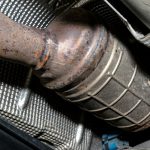How often should you be checking the steering fluid in your high-mileage vehicle? This is a question that many vehicle owners often grapple with. The answer is crucial, as it can prevent steering failure, a hazard you definitely want to avoid. In this informative guide, we delve into the heart of this matter, providing you with insights on the necessary frequency of steering fluid checks, the signs of steering fluid problems, and how to maintain your vehicle’s steering system at its optimal performance.
Understanding the Importance of Steering Fluid
The steering fluid in your vehicle plays a silent but significant role in ensuring your car operates smoothly and reliably. This fluid facilitates the transfer of force from the steering wheel to the steering mechanism, enabling you to control the vehicle’s direction.
Topic to read : How should you modify your braking technique after upgrading to ceramic brake pads?
The hydraulic fluid, commonly known as power steering fluid, lessens the effort needed to turn the steering wheel. It is specially designed to withstand high pressures and temperatures and resist degradation over time. However, like most components of your car, it isn’t invincible. It loses its properties over time due to contamination, leakage, or simply due to the age of the vehicle.
You may wonder, why should steering fluid maintenance matter to you? The answer is simple. Neglecting to check and replace your power steering fluid could lead to expensive repairs or even steering failure, which can pose severe safety risks.
Topic to read : What is the safest way to transport large glass items in a station wagon?
The Need for Regular Checks
The frequency of checking the steering fluid in high-mileage vehicles is a subject of debate among auto enthusiasts and mechanics. However, most experts agree on a certain guideline. They recommend checking the power steering fluid every month for high-mileage vehicles, especially those that have crossed the 75,000-mile mark.
Why is the monthly check necessary? High-mileage vehicles tend to suffer more wear and tear, and the power steering system is not exempted from this. The constant function of turning and maneuvering the vehicle puts significant stress on the system, leading to faster degradation of the steering fluid.
By checking the steering fluid every month, you ensure early detection of potential problems such as leaks, contamination, or low fluid levels. This proactive approach can save you from dealing with steering failure in the middle of the road.
Identifying Signs of Steering Fluid Problems
Being observant of your vehicle’s behavior is another excellent way to prevent potential steering failure. There are certain signs that indicate a problem with your vehicle’s steering fluid.
One of the most common symptoms is difficulty in steering, especially at lower speeds. If you find it unusually hard to turn the steering wheel, it could be due to low steering fluid levels.
Another sign is a whining or groaning sound when you turn the steering wheel. This noise is often caused by air entering the power steering system, indicating a potential leak.
Finally, if your vehicle’s steering wheel vibrates while idling, it’s a sign of contaminated steering fluid. This contamination can occur due to debris or due to the breakdown of the fluid’s chemical composition over time.
Maintaining the Vehicle’s Steering System
Regular checks and being observant of potential problems are critical, but they are only half the battle in preventing steering failure. You also need to ensure proper maintenance of the vehicle’s steering system.
Replacing the steering fluid is a primary step in this process. Most manufacturers recommend changing the power steering fluid every 50,000 miles or every two years, depending on which comes first.
The process of replacing the steering fluid, known as a power steering fluid flush, involves draining the old fluid, cleaning the system, and refilling with new fluid. It’s best to entrust this task to a qualified mechanic.
Additionally, regular servicing of the vehicle’s steering components is necessary. This includes checking and replacing worn-out parts such as the steering pump, hoses, and seals. Regular servicing not only ensures optimal performance but also extends the lifespan of the steering system.
Remember, a well-maintained steering system offers you not just a smooth and comfortable ride, but it also keeps you safe. Ignoring the state of your high-mileage vehicle’s steering fluid could lead to steering failure, compromising your safety and those on the road with you. Regular checks and proper maintenance are your best defense against such a situation.
Knowing When to Seek Professional Help
Understanding the signs of steering fluid problems is crucial, but equally important is knowing when to seek professional help. In some cases, the issues with your steering fluid may be beyond your capability to fix, and it’s in these instances that an experienced mechanic becomes invaluable.
Having a professional mechanic inspect your vehicle’s steering system can provide a comprehensive diagnosis of potential problems. Even if you are diligent with monthly checks, there could be hidden issues that only a trained eye can identify. For instance, steering fluid could be leaking from a small crack in the hoses or seals, or there could be internal damage to the steering pump.
Mechanics also have the necessary tools and knowledge to carry out a power steering fluid flush, which is recommended every 50,000 miles or every two years. This process involves replacing the old, degraded steering fluid with new fluid, ensuring your vehicle maintains optimal steering performance.
If you notice persistent problems even after topping up or changing your steering fluid, don’t hesitate to consult a professional. Remember, your safety and the safety of others on the road depend on the proper functioning of your vehicle’s steering system.
Conclusion
In summary, the steering fluid in high-mileage vehicles plays a pivotal role in ensuring smooth and reliable steering. Checking the steering fluid monthly, being aware of signs of potential problems, and not hesitating to seek professional help are key actions in preventing steering failure.
The importance of regular checks and proper maintenance cannot be overstated. These actions not only ensure your safety and the safety of others on the road, but they also can save you from expensive repairs down the line.
It’s easy to overlook the significance of the steering fluid, but it’s a component that warrants your attention, especially if you drive a high-mileage vehicle. The best approach is a proactive one that prioritizes regular checks, timely replacements, and professional assessments.
Remember, keeping your steering fluid at optimal levels and in good condition is not just about maintaining your vehicle; it’s about ensuring your safety and the safety of others on the road. A well-maintained vehicle is a safer vehicle. So, prioritize your steering system’s health and enjoy the peace of mind that comes with knowing you’re doing everything you can to prevent steering failure.











